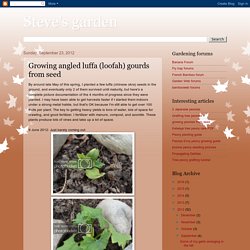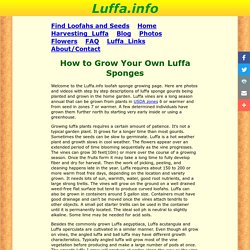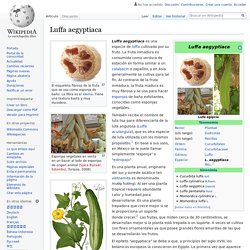

Steve's garden: Growing angled luffa (loofah) gourds from seed. By around late May of this spring, I planted a few luffa (chinese okra) seeds in the ground, and eventually only 2 of them survived until maturity, but here's a complete picture documentation of the 4 months of progress since they were planted.

I may have been able to get harvests faster if I started them indoors under a strong metal halide, but that's OK because I'm still able to get over 100 fruits per plant. The key to getting heavy yields is tons of water, lots of space for crawling, and good fertilizer. I fertilizer with manure, compost, and azomite. These plants produce lots of vines and take up a lot of space. 9 June 2012: Just barely coming out 30 June 2012: They are starting to make vines, but still haven't really taken off. 28 July 2012: They finally made it to the top of the trellis, but both of them are still not growing that fast yet. 11 August 2012: With 2 more weeks of growth, they have already taken over most of the trellis. Some of the fruits. 18 August 2012.
Luffa.info - Luffa/Loofah/Luffah/Loofa/Loufa/Luff Sponge Gourd Growing and Use Information. Find Loofahs and Seeds Home Harvesting_Luffa Blog Photos Flowers FAQ Luffa_Links About/Contact Welcome to the Luffa.info loofah sponge growing page.

Here are photos and videos with step by step descriptions of luffa sponge gourds being planted and grown in the home garden. Luffa vines are a long season annual that can be grown from plants in USDA zones 6 or warmer and from seed in zones 7 or warmer. A few determined individuals have grown them further north by starting very early inside or using a greenhouse. Growing luffa plants requires a certain amount of patience.
Como germinar luffa. Loofah, Luffa, Loofa, Exfoilating, Organic Sponge, Hand Made Soap – Luffa Gardens. COMO CULTIVAR LA ESPONJA VEGETAL LUFA (LOOFA, LOOFAH) Luffa aegyptiaca. El esqueleto fibroso de la fruta que se usa como esponja de baño.

La fibra es el xilema. Tiene una textura basta y muy duradera. Esponjas vegetales en venta en un bazar al lado de esponjas de origen animal (Spice Bazaar, Estambul, Turquía, 2008). Es una planta anual, originaria del sur y sureste asiático (en vietnamita es denominada mướp hương). Al ser una planta tropical requiere abundante calor y humedad para desarrollarse. El epíteto "aegyptiaca" se debe a que, a principios del siglo XVIII, los botánicos europeos la conocieron en Egipto. Referencias[editar] Ver también: Luffa (en inglés) en Kubitzki (ed). 2010. Enlaces externos[editar] Esponjas vegetales de Luffa - Esponjas vegetales de luffa 100% natural. Somos una empresa Agro forestal de Galicia, pioneros en el cultivo de Esponjas vegetales LUFFA para uso cosmético, somos la empresa europea más grande en cultivo, manipulación y transformación.
Disponemos de una genética propia y una fibra vegetal de muy alta calidad, nuestros productos están manufacturados en La Euro región Galicia- Norte de Portugal. Nuestro centro de transformación e Investigación está situado en la Villa termal de Caldas de Reis - Pontevedra Nuestras esponjas de baño y todos nuestros productos están tratados con agua termal a 43º, eso las convierte en únicas para la exfoliación tanto en seco como en húmedo. Nuestro producto es 100% natural, biodegradable y muy buenas para la piel, le adjunto un link donde se pueden ver los reportajes que realizo la TVE sobre nuestra empresa.
Mas información sobre el agua Termal - Growing Patola (Gourd) Part 1. The Luffa or Loofah/Luffah are tropical and subtropical annual vines comprising the genus Luffa.

The fruit of at least two species, Luffa acutangula and Luffa aegyptiaca, is grown to be harvested before maturity and eaten as a vegetable, popular in Asia and Africa. The Luffa acutangula is commonly known as Ridged Gourd and is called “zika” in Assamese, si gua in Mandarin Chinese, Turai in Hindi, Gisoda in Gujarati, Beerakaya in Telugu, heeray kAyi in Kannada, wetakolu in Sinhala, mrop khia in Vietnamese language, patola in Tagalog, kabatiti in Ilocano, and gambas or oyong in Indonesia. Loofah is a climbing vine related to gourds and cucumbers, and sometimes called the “dishrag vine,” a reference to the sponge-like qualities of the dried fruit. Six species are in the Luffa genus, and they are widely cultivated for food and sponge uses.
The loofah is the only plant source of sponge, and it has been used in bathhouses and kitchens for centuries. The Business Prospects of Loofah Part 2. Harvesting and Preparing Luffa Sponges Fruits are picked when they are dark green at the tender stage, before the angular ridges outside harden and fibrous network develops inside.

Once mature, they become bitter and inedible. While cooking, ridges of the loofah can be peeled off thinly but the remaining portion with skin is edible. When the sponges are ready for harvest they can be peeled. The skin loses green color and becomes looser when mature. If they have matured they are usually easy to get open. If they are stained, a soak in some bleach and water will lighten them considerably. Seeds should be allowed to dry and then stored in a cool place. Many Uses of Loofah These natural spongy wonders of the vegetable world have many uses. Luffa are most excellent in the bath or shower. Luffa sponges are great for washing items like plastic wares. Powdered luffa has also been used in Chinese herbal medicine. Care and Maintenance of Loofah Sponge Read part 1. The Luffa Farm located in Nipomo, CA. Loofah, Luffa, Loofa, Exfoilating, Organic Sponge, Hand Made Soap – Luffa Gardens.